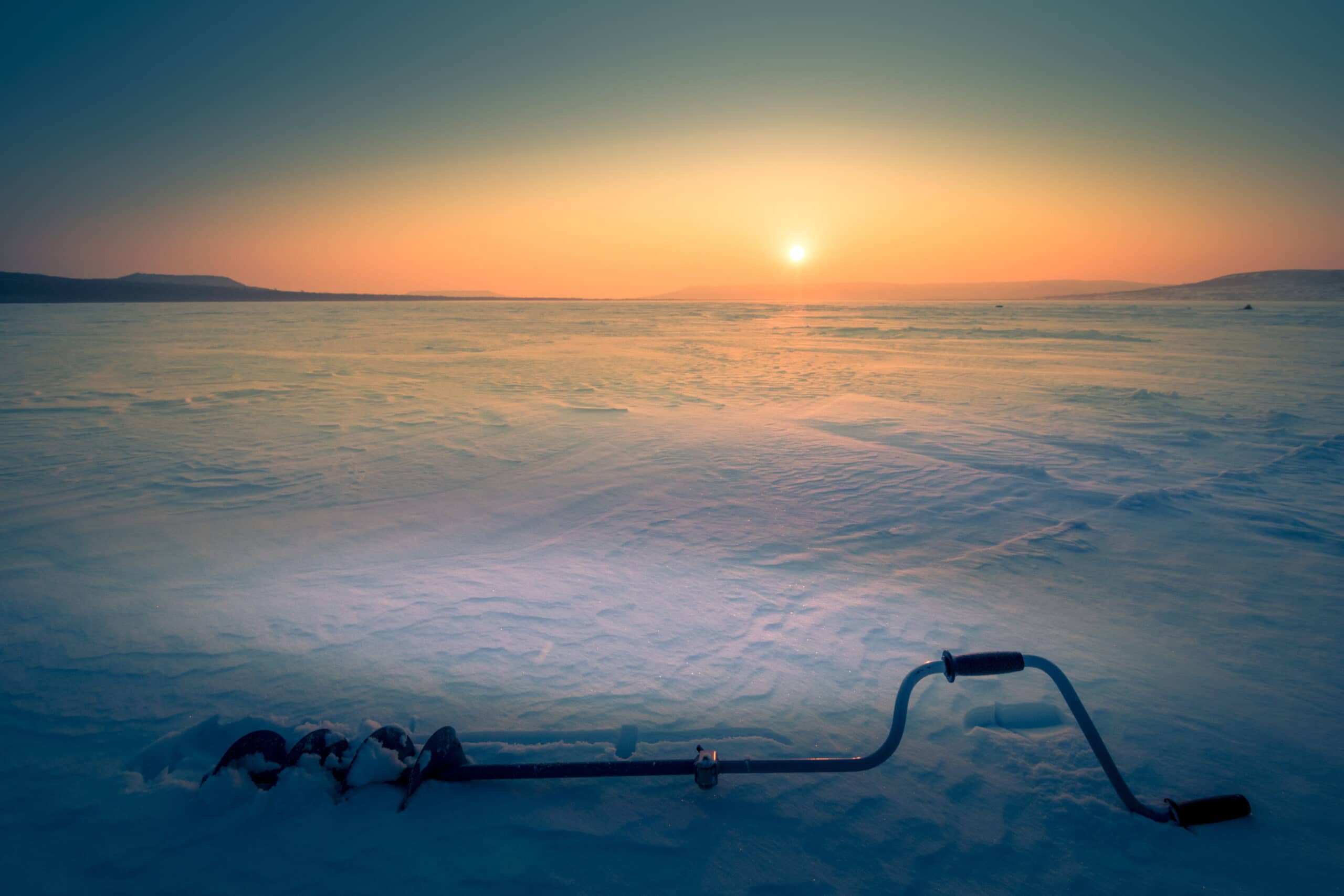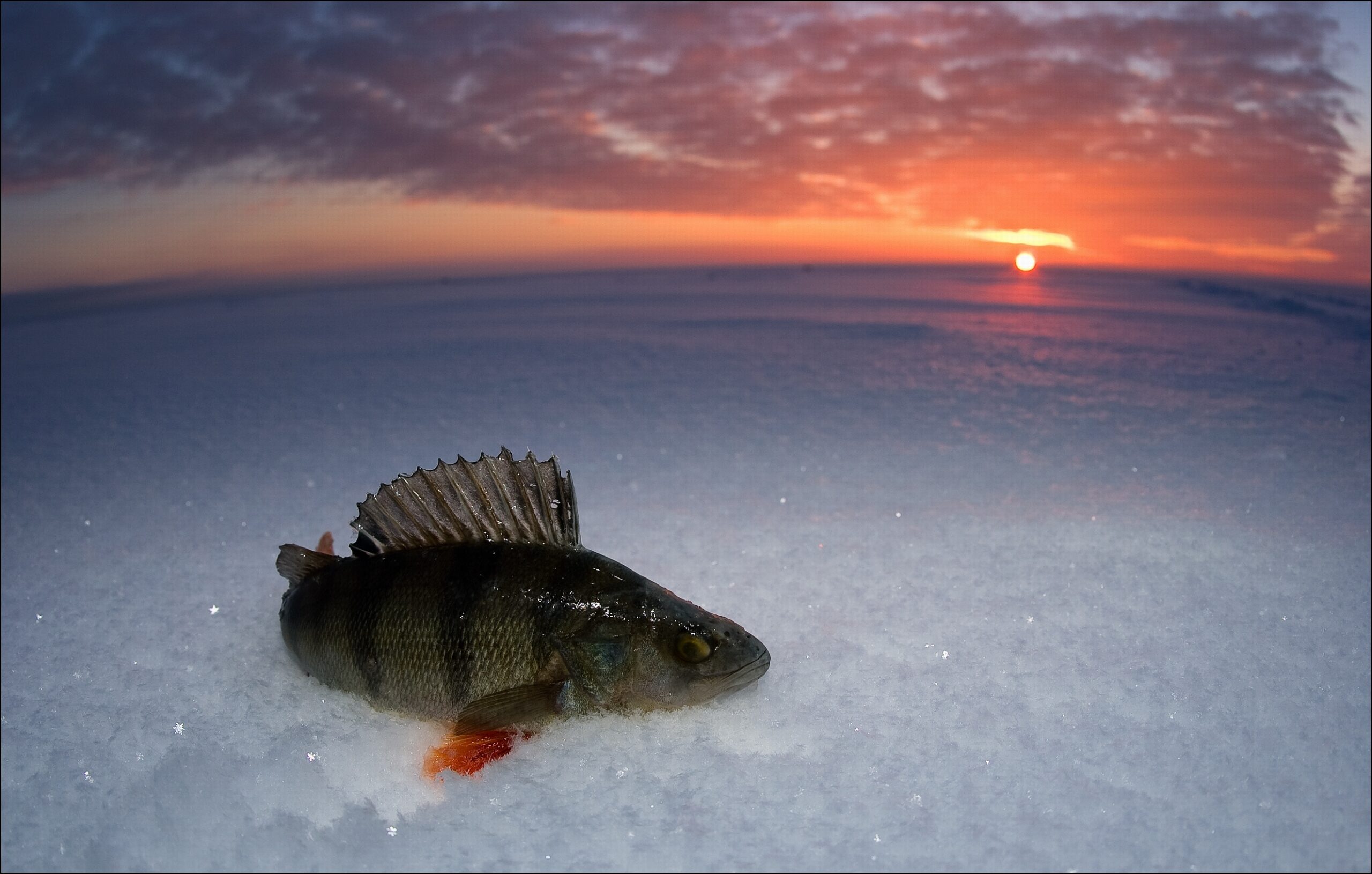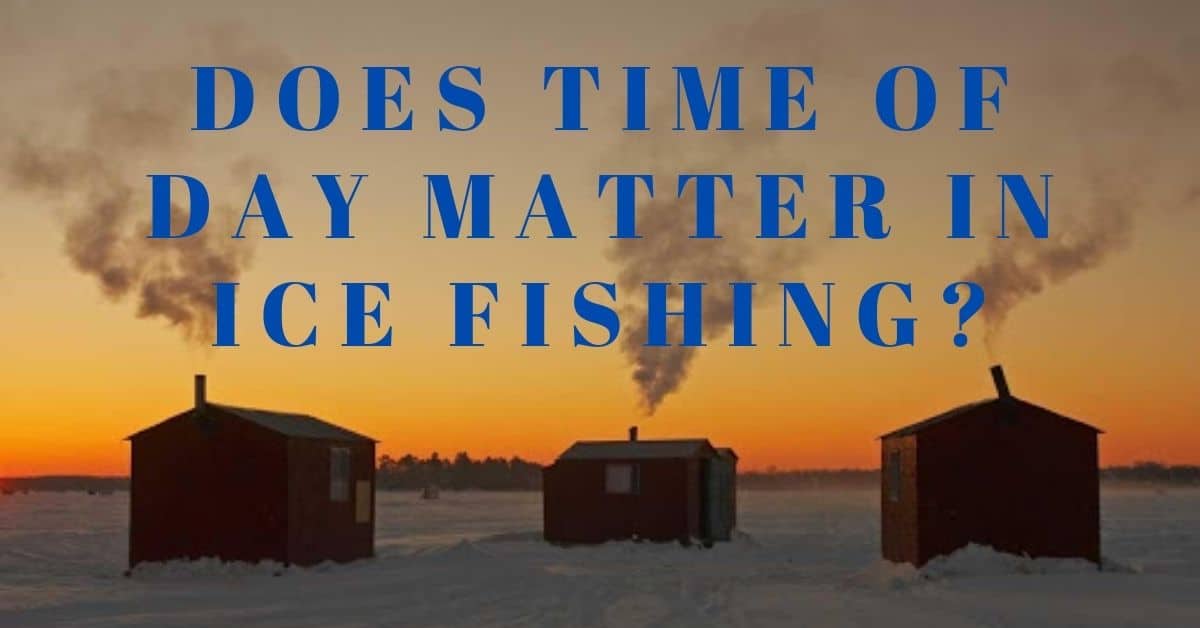If you are wondering what time of day matters when ice fishing you’ve come to the right place. I was also wondering what time of day or night would bring me the most success. After a lot of research (and many hours in the fishing hut) I’ve got some answers.
Time of day does matter when ice fishing. Fishing in transitional periods of the day, more specifically dawn and dusk, help increase your chances of catching fish
Ice fishing requires a lot of patience and a tolerance for the cold. However, with the proper guidance, you can make it at least a bit easier and it can be a lot of fun. So keep reading and I’ll dive down the ice hole to bring back some handy tips and tricks to help you on your ice fishing adventure.
Time of day does matter. Here’s why.
Fishing requires a basic understanding of fish psychology and metabolism. Fish act differently across seasons, and their activity varies from time of day. Therefore, understanding what they do during a time period is crucial to knowing when to ice fish.
When fishing, a rule of thumb is that fishing at dawn or dusk helps you guarantee a more productive fishing trip. However, this can vary for different types of fishing.
When ice fishing, we must take into consideration the freezing conditions above ground and in the lake. In the early mornings, the lake will be quite cold as will the aboveground ice.
Therefore, it is better to wait until the sun rises so it can warm up the lake a little. Take this time to check over your gear and to make sure you have everything for your fishing trip.
Fish move sluggishly during winters, so from the get-go, expect fishing sessions in the winter take a little longer compared to spring, summer, and autumn seasons. The cold waters cause the fish to be sluggish, and their metabolism slows down.
Dawn is Rush Hour For Fish
However, this does not mean that fishing at dawn is a total no-go. There is a short rush hour period during the morning that is incredibly productive for fishing. This rush hour is because fish swim upward during the evening and swim downwards during daybreak.
However, there are key factors that also help you be more productive when ice fishing. Drilling holes midday or late afternoon the day before fishing is crucial so that the fish will not be notified of your presence the morning after.
Another thing that alerts fish of your presence is when you fish on clear ice. The fish can see you! Fishing on snow-covered ice not only conceals you from the line of vision of fish, but many fish also prefer shaded areas.
Asking the locals the best spots is also important, as you would not want to fish on a lake with no fish. Doing some research on the internet is also very helpful for finding the best ice fishing spots of your desired location.
Dawn and Dusk. Which one is better for ice fishing?

Dawn and dusk are two time periods known to be the best time to ice fish, with reports showing that these periods are very productive. There have been many reasons why this is so.
One of the reasons is that the fish are heading out to their feeding areas or are more active during those periods. The increased activity during this period is probably due to the fish hiding from their predators in the dark.
Another reason why periods within dawn and dusk are great for ice fishing lies in explaining the abundance of food. Most fish are not fond of eating other fish, contrary to popular belief. Most feed on microscopic organisms called zooplankton, the primary source of food for fish.
During the low light hours, zooplanktons rise to the surface, and this is where fish will also rise to the surface to feed on the influx of planktons. However, which of the two is much better for ice fishing?
Referred primarily as the golden hour of ice fishing, this commonly missed timeframe by anglers is known to have the biggest and the best catches of the day. Most people start ice fishing an hour after the glimpse of sunlight; however, it may seem that to get the biggest and best catches, the early bird does get the worm.
1.Dawn
Setting up early is crucial not to alert the fish of your presence. Thirty minutes before sunrise, be sure to have your spots already picked out, have your holes drilled, and all of that ice fishing gear ready. It is the perfect time to intercept the fishes as they make their way into their relative feeding grounds.
The time frame of ice fishing during dawn is much shorter, especially when compared to dusk. However, with the right timing and with the right spot, you’ll surely get the golden hour of ice fishing within your very hands!
2.Dusk
After going out for the golden hour, be sure not to leave early just yet! After the relatively short time frame of dawn comes the highly lengthy time frame of dusk.
Like dawn, it is essential to prepare ahead. Fortunately, the holes used for fishing at the beginning can also be used for dusk. The time period for evening usually starts just before the sunset and two hours afterward.
Other species of fish are known to still bite even after midnight, so keep that in mind. However, be sure that you are warm and safe during the night as it may be harder to ask for help during the wee hours of the evening.
Time of day does matter. Especially for the type of fish.

Just like humans, different species of fish can be active at different periods of the day. Just like how you may be more productive during mornings than in evenings or vice versa, fish can also have specific characteristics attributed to their species.
For ice fishing, in particular, consider six specific fish species. These are the trout, pike, lake trout, walleye, kokanee, and panfish. Let’s look at these six in particular and know what time of day is best for catching these types of fish
Trout and Lake Trout
For trout, it is advisable to go with the traditional dawn and dusk advice. Unlike other fish, trout are very active in the winter and like shallow water. . Since most fish go deeper on warmer days (specifically at noon), fishing for trout at dawn and at dusk where the water is cooler is advisable.
Pike
Pikes are an oddity. For most fish, the dawn and dusk advice is pretty accurate. However, for the pike, the early afternoon is the best bet.
Pikes have horrible eyesight, and this makes them more active during bright conditions, namely early afternoons. They find their prey on weed beds, so looking for pike on weed beds is recommended.
Walleye
This fish is very compliant with the dawn and dusk advice. Fishing for walleyes in low light conditions such as an hour before and after sunrise and sunset is good advice. However, most anglers prefer to fish for walleyes from late afternoon to after dark.
Kokanee
A deep diver, this fish stays in groups in depths of 20 to 70 feet. However, like most fish, fishing for kokanee at dawn and dusk is pretty good advice. (3)
Panfish
Active on fallen trees, rock piles, and weed beds, panfish tend to hide from predators during the day. However, in low light conditions such as late nights and early mornings, panfish will be swimming around and will be nibbling your bait soon.
Below is a table indicating the best time to icefish certain species:
| Fish Species | Time of Day to Fish | Characteristics |
| Trout | Dawn|Dusk | Found in shallow water. Likes protein-rich bait. |
| Lake Trout | Dawn|Dusk | More active in low light conditions. Good to fish at dawn and dusk. |
| Pike | Late Morning|Early Afternoon | Midday | Has bad eyesight. More active in bright conditions. |
| Walleye | Night | Likes low light conditions. More optimal to fish in the evenings rather than early mornings. |
| Kokanee | Dawn|Dusk|Late Afternoon | Deep water dwellers. Hangs out in schools. |
| Panfish | Late Night|Early Morning | Found in areas where hiding places are prevalent. An example is rocks, debris, and weed beds. |
Take note of the signs. Weather does have a big impact on ice fishing.
Fish, like humans, respond accordingly to different conditions. For example, remember when COVID-19 first erupted and everyone was basically hoarding toilet papers, hand sanitizers, and food? Well, fish act in the same manner when they notice a disruption.
Most disruptions fish generally detect are weather disruptions. During cold fronts, during storms, fish act differently.
They say the best times in life are always the calm before the storm. With ice fishing, the same thing can be said as well. Ice fishing just before a storm is a good idea as fishes will be very active from here on out.
During the calm before the storm, the wildlife will start reacting heavily. For example, birds will start a feeding frenzy, so be sure to look out for strange behavior from birds. Below the waters, the fish are also on a feeding spree as they try to stock up on their food during the storm.
The fish also detects low pressure in the atmosphere. It is more effective to watch out for weather patterns rather than go ice fishing every day without enough yield. Camping during the “calm before the storm” period and fishing for the whole day from sunrise to sunset ensures you have great catches.
Another thing to watch out for are cold fronts. During cold fronts, fish will slow down, and so do your chances of getting a bite. So opting to wait for warmer weather will be well worth it.
The seasons and fishing in general
Ice fishing aside, all seasons have good opportunities for fishing. Open sea fishing is much more prevalent in hotter climates, while ice fishing is much more prevalent during winters. Nevertheless, let us look at how the seasons affect fishing in general.
Early season vs. late season, which one is better for ice fishing?
We all know for a fact that the early season tends to lean to the warmer side of things while the late-season leans to the colder side. This temperature disparity creates various effects not only on the ice fishing experience but also on the fish.
The early season tends to have thinner ice due to the warmer temperature. With the thinner ice, the fishing lake may be transparent. So not only can you see the fish, but the fish can also see you.
| Spring | Summer | Autumn / Fall | Winter | |
| Early Mornings | It’s not really biting at this point. The sun is still pretty low and the water is still cold. | The warm water makes the pace pick up. However, food is abundant and hungry fishes are non-existent. | Fish aren’t biting and the water is cool. (5) | Water is too cold. For ice fishing, a small window during dawn makes for great fishing. |
| Midday | It’s starting to pick up now. The water is starting to heat up. (5) | Don’t fish at this time of day. Most fish are not on the surface as they are cooling off below the water. (5) | Warmer water but still low yield. Not as low as early mornings. | Early midday is recommended for ice fishing. Generally not recommended. |
| Late Afternoons to Evenings | The metabolism of the fish is high and the water is warm. Expect high yield. | Not too warm and not too cold, the temperature is perfect. High yield expected. | Fish are putting in weight for the winter. Excellent fishing expected. | Evenings are perfect and make up for great fishing. |
Early season vs late season, which one is better for ice fishing?
When this happens, it is essential to conceal yourself. The reason this may be so is that fish are susceptible to their predators. Therefore, when they spot you above them, they may not take in the bait or may not go near your spot at all.
To prevent this from happening, it is encouraged to fish earlier in the day, where the sun is not yet out, and your presence will still not be very apparent. With the warmer waters, the fish will be nibbling on your bait very soon, and as the fish go closer to the surface due to the relatively warm water compared to the late-season waters, they are more in proximity to your bait.
Due to the relatively warmer temperatures, it is also easier to hold out longer in the cold, and fishing for the whole day will still be viable. However, during the late season, this may not be the case. With the sun rising later, expect a cold and harsh fishing experience.
The late-season also comes with its suite of problems. The fish during this time will be resting down at the bottom. Although you may not be very visible to them, fishing will definitely be slower than the early season with the thick ice and all.
Three frigid yet snappy frequently asked questions about ice fishing.
What fishing supplies must I have to do ice fishing?
Ice fishing may seem easy enough, but dig into it, and you will soon realize the number of things you need to have before you can even attempt it. We have listed a few essentials you may need to have while ice fishing.
- A bucket – buckets are essential for storing your fish in or keeping your bait fresh. It can also be used to transport gear easily.
- Rod and reel – this is self-explanatory. It will be the gear you will need to use to fish.
- Ice auger – used for breaking thick ice for ice fishing, this is an essential tool for you to drop your rod and reel in.
- Ice scoop – before you can even lower your rod and reel, you’ll need to scoop leftover ice after the ice auger using the ice scoop.
- Bait – used to bait fish into biting in your rod.
- Clothes – jackets, layers of clothing, boots, gloves, a hat, and a neck warmer are essential to keep yourself from freezing.
- Sled – for transport
- Metal cleats and safety picks – for safety and security
How will I know if a frozen lake is safe to fish on?
Maintaining at least four inches of thick ice can ensure your safety for walking and ice fishing. If the ice is less than four inches thick, don’t risk it. Maybe another day or another spot will do.
What should I do if I fall on a frozen lake?
It is essential to stay calm and not let the shock of falling through the ice get through you. The pain may be too much but keep your morale up.
Afterward, keep your winter clothes as a buoy. Contrary to popular belief, heavy winter clothes will not drown you but will lift you. The warm air within these clothes will help you float.
Next, head to the direction where you fell from. Use your hands and elbows to grip the ice and lift yourself.
Afterward, kick and pull. When you pull yourself up, stay horizontal to the ice and do not stand up. Instead, roll yourself out of the area and get to a warm place.


Cory Haasnoot
Cory is a content writer-editor and founder of Tackle Box Talk. Favorite Quote: "Give a man a fish, and you feed him for a day. Teach a man to fish, and you feed him for a lifetime."